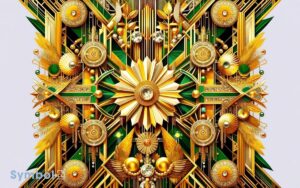What Did the Color Blue Symbolize in Flemish Painting
In Flemish painting, you’ll find the color blue teeming with spirituality and status. It’s not just a color but a bridge to the divine, steeped in celestial purity. When you see lapis lazuli gracing the Virgin Mary’s robe, you’re observing a symbol of unparalleled sanctity.
This hue wasn’t just chosen for its beauty; its rarity spoke of exclusivity and high social status. Artists skillfully crafted narratives around its scarcity, embedding messages of loyalty, trustworthiness, and a profound bond with the celestial domains.
Engaging with these masterpieces further, you’ll uncover the nuanced layers that blue weaves throughout Flemish art’s rich tapestry.

Key Takeaway
Divine Connection
In Flemish painting, the color blue often serves as a symbolic bridge to the divine, embodying spiritual purity and celestial worlds.
You’ll find that artists meticulously employed this hue to signify an ethereal presence, transcending the everyday to hint at the infinite.
This choice wasn’t merely aesthetic; it was deeply rooted in the cultural and religious beliefs of the time, where blue was associated with trustworthiness, faith, and the heavens.
Through their skillful application, painters could imbue a scene or figure with a sense of sanctity, suggesting an otherworldly connection without explicit depiction.
Analyzing these works, you’re invited to perceive beyond the visual, into a domain where color becomes a medium for profound spiritual communication, elevating the narrative beyond its earthly confines.
Virgin Marys Robe
One of the most iconic uses of blue in Flemish painting is found in the depiction of the Virgin Mary’s robe, symbolizing her purity, divinity, and the profound celestial connection she embodies.
This choice of color wasn’t merely aesthetic; it was laden with theological and symbolic significance.
In the context of Flemish art, blue wasn’t just a color but a narrative device, conveying Mary’s exceptional role in Christian theology as the mother of Jesus.
Artists meticulously selected shades of blue, often lapis lazuli, to not just capture the eye but to narrate her sanctity and virtue.
This deliberate use of blue underscores its importance not only in depicting religious figures but also in conveying messages of spiritual purity and ethereal connection without the need for words.
Social Status Indicator
When exploring the role of blue in Flemish painting, it’s crucial to acknowledge how the use of Lapis Lazuli not only conveys a sense of exclusivity but also serves as a potent indicator of social status.
The hierarchical implications of colors in these artworks can’t be overstated, with blue often denoting nobility, divinity, and wealth.
This association underscores the intricate relationship between color, material value, and societal stratification in the Flemish art context.
Lapis Lazuli Exclusivity
Given its rarity and the complex process required for its extraction, lapis lazuli‘s use in Flemish painting became a definitive marker of social status, reflecting both the wealth and the prestige of the artwork’s patron.
You must appreciate that acquiring lapis lazuli involved intricate trade networks extending from the mines of northeast Afghanistan to the flourishing art markets of Europe.
This not only made the pigment prohibitively expensive but also limited its use to the most esteemed commissions.
In the hands of master painters, this vibrant blue transcended mere aesthetic appeal, embodying a tangible display of power and divine favor.
Its presence in a painting didn’t just enhance the visual impact; it whispered tales of its patron’s unparalleled status and influence within society.
Colors Hierarchical Implications
In the domain of Flemish painting, the choice of colors served not merely as an aesthetic decision but as a deliberate indicator of social hierarchy, subtly revealing the patron’s rank and wealth.
You’ll find that the use of blue, particularly, was emblematic of prestige. Its rarity and the expense of the lapis lazuli pigment meant that only the wealthiest could afford such displays.
This hierarchical implication extended beyond mere possession, intertwining with themes of divinity and morality.
The Virgin Mary, often depicted in a resplendent blue mantle, exemplified purity and heavenliness, further elevating the color’s status.
When analyzing these artworks, you’re not just appreciating visual beauty but decoding a complex system of social signifiers, meticulously woven into the fabric of Flemish society.
The Rarity of Lapis Lazuli
You’ll find that the scarcity of Lapis Lazuli greatly elevated its value, making it a symbol of luxury and exclusivity in Flemish painting.
This rare pigment’s impact on the art market was profound, as it not only enhanced the aesthetic appeal of artworks but also their financial worth.
Consequently, paintings adorned with Lapis Lazuli blue became coveted items, reflecting both the skill of the artist and the wealth of the patron.
Lapis Lazulis Exclusivity
Why was lapis lazuli, a semi-precious stone of vibrant blue, so highly sought after in the domain of Flemish painting, despite its notable rarity and exorbitant cost? Its exclusivity is rooted in:
- Geographical scarcity: Lapis lazuli’s primary source was the remote Sar-e-Sang mines in Afghanistan, making its acquisition a challenging task for European artists.
- Complex extraction process: Turning the raw stone into the coveted ultramarine pigment required a laborious process, enhancing its value.
- Symbolic significance: Beyond its aesthetic appeal, the intense blue pigment symbolized divinity and purity, imbuing artworks with a spiritual dimension.
These factors combined to make lapis lazuli not just a pigment but a statement of wealth, devotion, and artistic ambition in Flemish painting.
Impact on Art Value
Understanding the exclusivity of lapis lazuli emphasizes its profound impact on the value of Flemish paintings, where its rarity significantly elevated the artworks’ prestige and market worth.
| Emotion | Impact on Viewer |
|---|---|
| Awe | Lapis’s deep blue fosters a sense of wonder. |
| Respect | Acknowledgment of the artist’s access to such rare materials. |
| Curiosity | Intrigue about the origins and value of the pigment. |
| Appreciation | Gratitude for the painstaking effort to obtain and use lapis. |
| Connection | Feelings of closeness to a time when such colors were treasured. |
Symbol of Fidelity
In Flemish painting, the color blue often serves as a potent symbol of fidelity, embodying the depth and constancy of loyalty and trust. This symbolic usage isn’t arbitrary but deeply rooted in the cultural and historical contexts of the time.
To understand this symbolism, consider the following:
- Historical Context: Blue pigments were rare and costly, suggesting the value and preciousness of true loyalty.
- Cultural Significance: In many Flemish works, blue is associated with steadfast characters, reinforcing societal ideals of faithfulness.
- Artistic Techniques: Artists skillfully employed shades of blue to convey emotional depth, highlighting the seriousness of commitment.
This nuanced application of blue not only enriches the artwork’s aesthetic but also deepens its emotional resonance, offering viewers a layered understanding of fidelity’s intrinsic value.
Portrayal of the Heavens
The portrayal of the heavens in Flemish painting often utilizes the color blue to evoke a sense of the divine and the infinite, reflecting an intricate blend of religious symbolism and artistic innovation.
This choice isn’t arbitrary; it’s steeped in a historical understanding of blue as a mediator between the earthly and the celestial.
Renaissance scholars and theologians posited that the heavens were a crystalline sphere enveloping the earth, a concept visually translated by artists through the use of lapis lazuli and azurite pigments.
These materials weren’t only prized for their vibrant hues but also for their rarity and cost, further elevating the spiritual significance of their application.
Blue transcends mere color, embodying a bridge to the ethereal, a visual hymn to the mysteries beyond the mortal coil.
Reflections of Nature
Through the lens of Flemish painting, blue not only captures the divine but also mirrors the natural world with unparalleled depth and fidelity, offering a window into the artists’ profound connection with nature.
This reflection of nature through the color blue is evident in:
- Landscape Elements: Blue is frequently used to depict the vastness of the sky and the depth of the sea, embodying the artists’ awe and reverence for the natural world.
- Floral Motifs: Flowers painted in hues of blue symbolize not just beauty but also the transient nature of life, inviting contemplation on the cycle of birth and decay.
- Animal Representations: The use of blue in depicting animals emphasizes their inherent nobility and the harmony between the natural and spiritual domains.
Conclusion
In your exploration of Flemish painting, you’ve revealed the multifaceted symbolism of blue. This color, beyond its visual appeal, served as a divine hotline, especially woven into the Virgin Mary’s robe, signifying her celestial grace.
It wasn’t just a hue but a status symbol, thanks to the exorbitant lapis lazuli. Blue also embodied fidelity, mirrored the heavens, and captured nature’s essence. For centuries, blue’s allure extended into art, fashion, and power, shaping perceptions and influencing cultures around the globe. Its profound symbolism resonates even today, as seen in national banners like the Colombian flag. The Colombian flag colors meaning ties blue to the skies and oceans that connect the nation, yellow to its golden prosperity, and red to the enduring resilience of its people.
Fascinatingly, it was the medieval equivalent of today’s ‘blue checkmark,’ denoting prestige and authenticity in a world awash with color.






